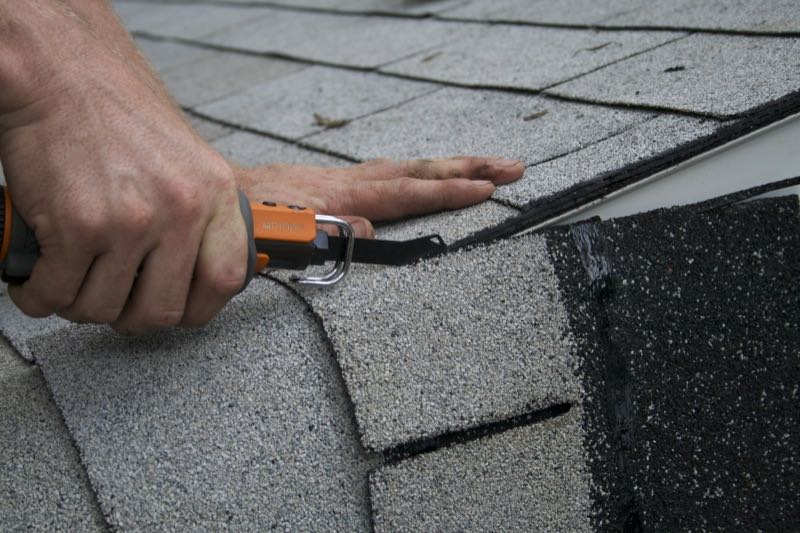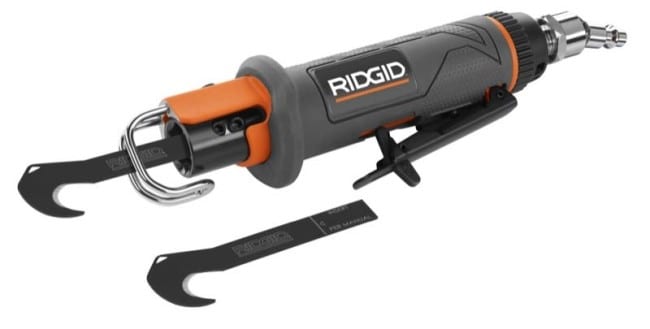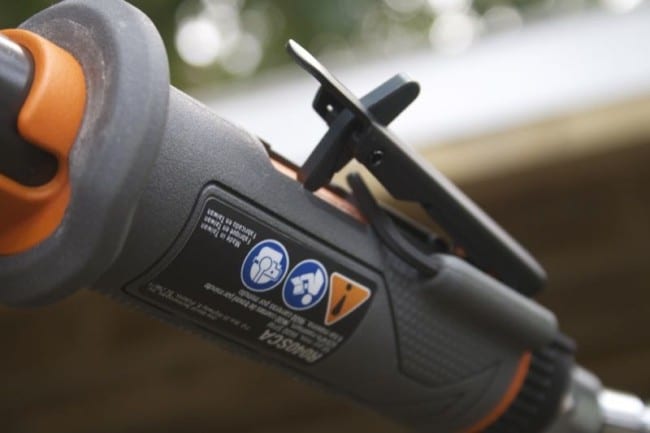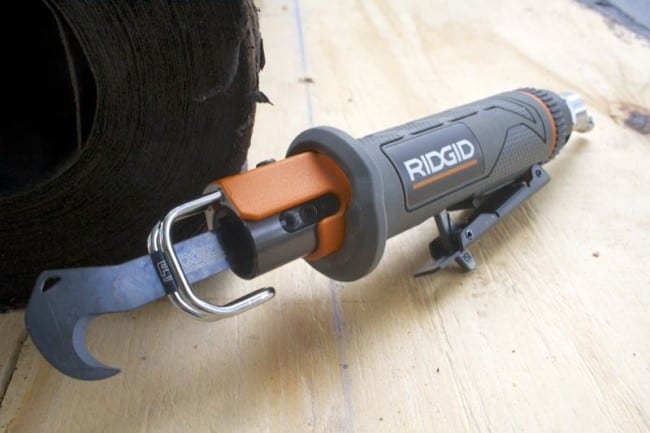One of the most difficult parts of installing a new roof (there are so many to choose from) is cutting away the shingles that you run over the side of the drip edge as you make your way up the peak. Typically you do this with a combination of heavy duty hook or straight blades, depending upon whether you’re cutting from the front or backside of the shingles. The Ridgid Roofing Cutter provides a way to use the pneumatic air line you’ve already got run to the roof and simplify a job that was previously quite tedious and which required several blade changes to accomplish.
Looking at the tool, I have to admit that I didn’t understand at first how it would fare. A pulsating front to back motion at high speed with a curved hook blade doesn’t, at first, appear to be the desired motion to cut shingles. Turns out, as I’ll demonstrate later in the review, it’s spot-on.
Ridgid Roofing Cutter Build Quality
So looking at the Ridgid roofing cutter, the first thing that stands out is that you have what is essentially a pneumatic device with a metal paddle switch. The paddle switch has a default state in which it is locked in the ‘off’ position by a spring-loaded safety bar that blocks the switch from being activated when you set the tool down. It’s a simple matter of gripping the tool correctly so that your hand slides the bar out of the way when you want to squeeze the paddle switch to activate the Ridgid roofing cutter.
Like the Ridgid Gen5X cordless power tools, the Roofing Cutter features the company’s Hex Grip rubberized overmold, which is a slip-resistant grip that gives you a solid hold on the tool with both gloved and bare hands. The tool includes two hook blades which are proprietary but can be purchased in 3-packs for just $7.99. The blades secure within the tool by clamping in place with two hex screws. A hex/Allen key is included with the tool and actually stores right in place beside the paddle switch.
Another nice feature of this tool is that it comes with a 1/4″ swivel quick connect. It’s always amazing to us when we get a pneumatic tool and discover that the manufacturer doesn’t include a 1/4″ quick connect. Not so with Ridgid, and you’re pretty much ready to go right out of the box.
About the only other thing to mention is that even though this tool is small and maneuverable, Ridgid still gives users the ability to direct the exhaust air via a rear-mounted dial. This was a thoughtful feature, and once you set it you’ll likely never have to touch it again until you switch hands.
Field Testing the Ridgid Roofing Cutter
The first thing you do with the Ridgid roofing cutter (after you supply air to it) is install one of the two included hook blades. Looking at the blades, I wondered why Ridgid didn’t utilize a standard reciprocating saw shaft – something that would mean that you could actually put a saw blade on this tool and get some dual use out of it as a makeshift one-handed, low torque, short-throw recip saw. Ridgid also has a brand new pneumatic JobMax Multi-Tool, so they’ve got this covered, but flexibility is almost always a good thing, and a tool-less blade change is generally preferable to one that requires a hex key. In either case, the hex key was simple to remove from the tool and use to loosen and then tighten the two screws which hold the blade in place. There are even marks on the blade so you know how deep it needs to be inserted into the shaft.
For an air supply I utilized the Bosch CET4-20W 4 gallon jobsite compressor and set the output pressure to 90 PSI as indicated by the user manual (yes I read it, it’s part of the job). The tool is lightweight at just over a pound and maneuvering it into place is quite easy. Once I started cutting I found that the tool slid through the shingle layers like butter, easily staying positioned against the drip edge for a very nice finish. I was able to work my way down the edge of the roof in a nice smooth motion. It was not only faster than using a utility knife, but also a lot cleaner and safer. There have been times when I was cutting with a knife wondering amazed that I still had all of my fingers intact when the job was finished. Part of this is because you’re often moving as quickly as possible, and another part is because it’s one of those tedious jobs that often finds you taking your mind off what you’re doing. The Ridgid roofing cutter doesn’t give you enough time to think about anything else – it cuts too darn quickly.
Another added benefit is that the blade doesn’t seem to rip up the drip edge like even the best razor knife often does. If you move too quickly with a razor knife, aluminum drip edge can get scraped up enough to take off the color coating in areas. With the Ridgid R040SCA shingle cutter, we didn’t even have to try hard and our drip edge stayed white.
The only concern we had about the roofing cutter was the blade of the life. Since the blades are proprietary we wondered if they would last long and if they would be easy to locate, considering the tool used a proprietary connection method and non-standard blades. Turns out, the tool will slice through shingles with the shaft of the blade. That’s right, you don’t even need the blade to be sharp – its a factor of the 9600 strokes per minute. It simply provides so much friction, the tool literally melts its way through. We took a piece of shingle, held it in the air, and simply sliced through it using the tool positioned half way down the blade shaft. It cut at virtually the same speed. Wow.
Conclusion
Ridgid tries to assign a number to how quickly it cuts, and I suppose they did some time trials. Between the safety aspect of this tool and the fact that it cuts smoothly and easily without messing up your drip edge – I say “who cares?” It’s faster – much faster – and that’s all you really have to know to want to spend the measly $99 to add this to your arsenal. And as I’m fond of saying, ANY tool that speeds up a roofing job is a good tool to have. This tool qualifies.





